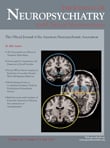Olanzapine-Induced Tardive Dystonia Successfully Treated by Tetrabenazine
SIR: Tardive dystonia (TD) is one of the tardive syndromes, along with tardive dyskinesia, and tardive akathisia. It is an adverse effect [BR2] usually associated with conventional antipsychotics, though it has also been observed in patients treated with atypical antipsychotics, particularly olanzapine. 1 , 2 Tardive dyskinesia is uncommon, severe, and debilitating, 3 rarely remits completely and has no proven remedy. 4 Dopamine-depleting agents, such as tetrabenazine, have shown a beneficial effect on TD, 5 but efficacy has yet to be proven. We present an unusual case of TD that emerged after 5 years of olanzapine monotherapy, and did not remit 1 month after olanzapine discontinuation, but successfully resolved following initiation of tetrabenazine therapy.
Mr. M, 47-years-old, diagnosed with chronic schizophrenia, had an unremarkable medical past, and no family history of movement disorders. Since the year 2000, M. was treated with olanzapine (5 mg/day) monotherapy, with no adverse effects. His condition was described as partial remission with stable deficit. During February 2006 he began complaining about periodic involuntary continuous painful muscle spasms in the neck, which lasted a few minutes. Within 3 months symptoms increased in length, severity and frequency. Moreover, the chest and upper abdomen were also involved in involuntary contractions causing heavy breathing and eating difficulties and repeated vomiting. Each respiration was accompanied by unilateral neck spasms, cramps, leading to regurgitation and difficulty in breathing. He tried to support himself to prevent muscle contractions, but without success. M. became afraid and distressed. He was referred to a general hospital and underwent comprehensive medical and neurological examinations. Somatic pathology was excluded. His laboratory tests (blood oxygenation, CBC, thyroid hormones, electrolytes, magnesium, calcium, copper, liver enzymes) and brain CT scan were normal and he was eventually diagnosed with drug-induced tardive dystonia. Olanzapine was stopped in June 2006 but the tardive dystonia continued. Adjunctive clonazepam (2 mg/day) was not beneficial. One month later, tetrabenazine (25 mg/day) was initiated, and gradually uptitrated to 75 mg/day. During the second week of treatment his condition improved and within 4 weeks almost all involuntary movements remitted. Quetiapine 100 mg/day was started in August 2006 with adjunct tetrabenazine, and he remains free of involuntary movements.
Tardive dystonia is a late-onset side effect of antipsychotic treatment, with persistent dystonic movements of focal onset involving mainly the craniocervical region. In our case, the dystonia appeared after 5 years of olanzapine treatment, was multifocal including the neck, chest and upper abdomen, accompanied by labored breathing and eating disturbances. Its unusual presentation made diagnosis difficult. Commonly proposed treatment interventions such, as neuroleptic discontinuation and benzodiazepines were ineffective. Paleacu et al. 5 reported moderate effect of tetrabenazine on movement disorders. We observed a pronounced and quick effect of tetrabenazine on distressing, and severely debilitating TD. Further study is warranted to confirm the efficacy of tetrabenazine in intractable cases of TD.
1 . Gunal DI, Onultan O, Afsar N, et al: Tardive dystonia associated with olanzapine therapy. Neurol Sci 2001; 22:331–332Google Scholar
2 . Charfi F, Cohen D, Houeto JL, et al: Tardive dystonia induced by atypical neuroleptics: a case report with olanzapine. J Child Adolesc Psychopharmacol 2004; 14:149–152Google Scholar
3 . Wojcik JD, Falk WE, Fink JS, et al: A review of 32 cases of tardive dystonia. Am J Psychiatry 1991; 148:1055–1059Google Scholar
4 . Papapetropoulos S, Wheeler S, Singer C: Tardive dystonia associated with ziprasidone. Am J Psychiatry 2005; 162:2191Google Scholar
5 . Paleacu D, Giladi N, Moore O, et al: Tetrabenazine treatment in movement disorders. Clin Neuropharmacol 2004; 27:230–233Google Scholar



